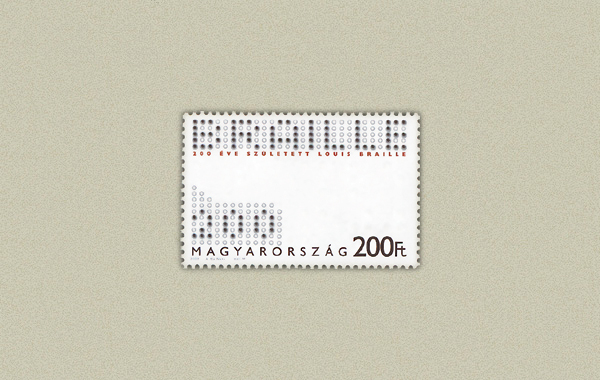
1. MAGYAR - 200 ÉVE SZÜLETETT LOUIS BRAILLE - Bélyeg rendelési kód: 2009 év bélyegei kompletten
2. ENGLISH - BICENTENARY OF THE BIRTH OF LOUIS BRAILLE - Order code of the stamp: 2009 Year stamps complete
3. GERMAN - VOR 200 JAHREN WURDE LOUIS BRAILLE GEBOREN - Die Bestellnummer Der Marke: 2009 Jahr Briefmarken komplett
1. MAGYAR - 200 ÉVE SZÜLETETT LOUIS BRAILLE
A Magyar Posta – a Fehér bot napján – alkalmi bélyeg kibocsátásával köszönti Louis Braille születésének 200. évfordulóját.
Louis Braille (1809-1852) egy Párizs közeli faluban született és hároméves korában egy baleset következtében vesztette el a látását. Édesapja műhelyében egy éles szerszámmal játszott, amivel megsebezte a szemét. A seb elfertőződött, és hamarosan mindkét szeme világát elvesztette. Először látó gyermekekkel járt iskolába és hallás útján tanult.
Tízéves korában ösztöndíjat kapott a Párizsi Vakok Intézetétől, de az elképzelésekkel ellentétben a tanárok itt is csak beszéltek a diákokhoz. Az intézmény könyvtárában volt ugyan néhány terjedelmes könyv, amelyben domború „látó”-betűkkel írt szöveg volt, de ezeket nagyon nehéz volt a vak gyermekeknek olvasni.
1821-ben, egy katona, Charles Barbier látogatta meg az iskolát, és ismertette meg a vak gyermekekkel találmányát, az ún. „éjszakai írás”-t. A tizenkét domború pontból álló rejtjeles írásnak köszönhetően a katonák a sötétben beszéd nélkül oszthatták meg egymással a fontos információkat. A vakírás elkészítéséhez az ötletet és az alapot Braille számára ez a titkosírás adta. A tizenkét pontot hatra csökkentette, és tizenötéves korára egy kiforrott írásrendszert alkotott meg.
Az iskola elvégzése után egy párizsi templomban orgonált. Később, 1826-ban a francia vakok iskolájának professzorává választották.
Tanárként is az a cél vezérelte, hogy egy teljes rendszert fejlesszen ki a vakok számára. Nem elégedett meg az írásjelek és a számok lefordításával, hanem a matematika és a zene szimbólumait is hozzáadta a vakok ábécéjéhez. Töretlenül haladt előre és a társadalom kételkedése sem befolyásolta abban, hogy diákjainak sikeresen tanítsa meg a pontírást. Munkájának eredményeként 1829-ben adták ki az első Braille-könyvet.
1852. január 6-án halt meg tuberkolózisban. A párizsi Pantheonban nyugszik. Méltatói szerint hátrahagyta a vakok számára a kulcsot, amellyel beléphetnek az egyetemes tudomány és a világ megismerésébe. Forrás: www.gravobraille.hu
Megjelenési időpont: 2009. október 16.
Forrás: Posta
2. ENGLISH - BICENTENARY OF THE BIRTH OF LOUIS BRAILLE
On White Stick Day, to mark the bicentenary of the birth of Louis Braille, Magyar Posta is issuing a commemorative stamp.
Louis Braille (1809-52) was born in a village near Paris and at the age of three lost his sight as the result of an accident. He injured his eye while playing with a sharp tool in his father’s workshop. An infection set in and soon he lost his sight in both eyes. At first he went to school with sighted children and learnt by hearing. When he was ten, he won a scholarship to the Institute for the Blind in Paris but, contrary to expectations, the teachers there only spoke to the children. Although there were a few large books with raised letters in the Institute’s library, these were very heavy and difficult for the blind children to read.
In 1821 an army officer, Charles Barbier, visited the school and showed the blind children his invention called “night writing”, a secret code of 12 raised dots that allowed soldiers to share information in the dark without speaking. This secret writing gave Braille the idea and the basis for devising his writing for the blind. He reduced the number of dots to six and by the age of fifteen created a complete writing system.
After finishing school, he played the organ in a Parisian church. Later, in 1826, he was given a teaching post at the French school for the blind. As a teacher he was guided by the goal of developing a full system for the blind. He was not satisfied with transcribing letters and numbers, and added mathematical symbols and musical notation to the alphabet for the blind. He made steady progress and was not deterred by society doubting that he could successfully teach his pupils using his dot writing. As a result of his work, the first book written in Braille was published in 1829.
Braille died of tuberculosis on 6 January 1852. His body now lies in the Pantheon in Paris. He was honoured for giving the blind the key to universal knowledge and learning about the world. Source: www.gravobraille.hu
The special feature of the stamp marking the bicentenary of the birth of Louis Braille, the inventor of writing for the blind, is that the legend “BRAILLE 200” is also written in Braille. There is likewise writing in Braille on the first day cover for the stamp, and the special postmark contains a stylized graphic design of a combination of an eye and dots used in Braille writing.
Date of issue: 15 October 2009
3. GERMAN - VOR 200 JAHREN WURDE LOUIS BRAILLE GEBOREN
Die Magyar Posta begeht – am Tag des Weißen Stockes – den 200. Jahrestag der Geburt von Louis Braille mit der Ausgabe einer Sonderbriefmarke.
Louis Braille (1809 - 1852) wurde in einem Dorf bei Paris geboren und verlor im Alter von drei Jahren infolge eines Unfalls sein Augenlicht. Er spielte in seines Vaters Werkstatt mit einem spitzen Werkzeug und verletzte sich dabei ein Auge schwer. Die Entzündung erfasste auch das andere Auge und führte bald zur Erblindung des Jungen. Zunächst ging er mit sehenden Kindern zur Schule und lernte nach Gehör. In seinem zehnten Lebensalter bekam er ein Stipendium am Blindeninstitut in Paris, aber entgegen seinen Vorstellungen wurde auch hier nur gesprochen. Zwar gab es in der Bibliothek des Instituts einige umfangreiche Bücher, in denen Texte mit erhabenen „sehenden" Buchstaben geschrieben standen, aber für die blinden Kinder waren sie sehr schwer zu lesen.
1821 besuchte ein Soldat namens Charles Barbier die Schule und machte die blinden Kinder mit seiner Erfindung, der sog. „Nachtschrift” bekannt. Dank der aus zwölf erhabenen Punkten bestehenden chiffrierten Schrift konnten die Soldaten die schriftlichen Befehle auch im Dunkeln lesen, ohne eine Laterne anzuzünden. Später entwickelte Braille aus dieser Nachtschrift seine Blindenschrift, er reduzierte die Anzahl der Punkte pro Zeichen von zwölf auf sechs und schaffte im Alter von fünfzehn Jahren ein brauchbares Schriftsystem.
Nach dem Schulabschluss spielte er in einer Pariser Kirche Orgel. Später, im Jahr 1826 wählte man ihn zum Professor der französischen Blindenschule. Auch als Lehrer arbeitete er weiter daran, ein geeignetes System für die Blinden zu entwickeln. Er gab sich mit der Übersetzung der Schriftzeichen und Zahlen nicht zufrieden, sondern fügte dem Alphabet der Blindenschrift auch die Symbole der Mathematik und der Musik hinzu. Er arbeitete ungebrochen weiter und auch das Ausbleiben der offiziellen Anerkennung hinderte ihn nicht daran, seinen Schülern die Punktschrift erfolgreich beizubringen. 1829 erschien als Krönung seiner Arbeit das erste Braille-Buch.
Er starb an einem Lungenleiden am 6. Januar 1852. Seine Gebeine wurden im Pariser Pantheon beigesetzt. Nach seinen Würdigern hinterließ er den Blinden den Schlüssel, der ihnen Zutritt zum Kennenlernen der universellen Wissenschaften und der Welt gewährt. Quelle: www.gravobraille.hu
Die Bizentenarium-Sondermarke begeht den 200. Jahrestag der Geburt von Louis Braille, des Erfinders der Blindenschrift, und als ihre Besonderheit ist die Überschrift „BRAILLE 200” darauf auch mit der Blindenschrift von Braille lesbar. Der zur Briefmarke gehörende Sonderumschlag enthält ebenfalls Blindenschrift, auf dem Sonderstempel ist eine die Verschmelzung des Auges und der Punkte der Braillezeichen darstellende stilisierte grafische Komposition zu sehen.
Erscheinungsdatum: 15. Oktober 2009


